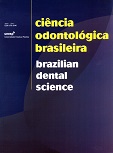Avaliação in vitro da resistência ao desgaste de dentes artificiais
DOI:
https://doi.org/10.14295/bds.2005.v8i3.430Abstract
O correto restabelecimento da dimensão vertical de oclusão é um dos grandes desafios da odontologia reabilitadora. Por-tanto, a seleção de dentes artificiais com melhores propriedades físicas e mecânicas facilita a manutenção dessa relação. O objetivo deste trabalho foi avaliar a resistência ao desgaste de dentes artificiais de resina por meio de ensaios mecânicos realizados em máquina de escovação. Oito grupos (G I – Postaris, G II – Gnatostar, G III – Vitapan, G IV – Triostat, G V – Trilux, G VI – VipiDent, G VII – Artiplus e G VIII – Biotone), compostos de cinco pré-molares superiores de cada fabricante, foram pesados em balança analítica eletrônica e medidos em sua altura por um micrômetro antes e após os ciclos. Para que os dentes fossem fixados à haste da máquina, foram embutidos em um bloco de resina acrílica de forma que a ponta de cúspide vestibular entre em contato com a amostra do antagonista. Foram realizados 372 ciclos por minuto, num total de 200.000 vezes em uma distância de deslize de 20mm por ciclo em direção vestíbulo-lingual, sob carga axial de 400g. Durante o processo, os dentes foram irrigados com água destilada em ambiente com temperatura controlada pela máquina de 25oC. O material de escolha para o antagonista foi porcelana feldspática de esmalte preparado como uma placa de 24x12x3mm aplicada sobre uma infra-estrutura de liga de níquel-cromo. Os resultados foram submetidos à análise estatística de Tukey com nível de significância p=0,05. Não foram encontradas diferenças significantes entre os grupos para as avaliações de perda de peso e altura.Downloads
Downloads
Published
How to Cite
Issue
Section
License
Brazilian Dental Science uses the Creative Commons (CC-BY 4.0) license, thus preserving the integrity of articles in an open access environment. The journal allows the author to retain publishing rights without restrictions.
=================




























